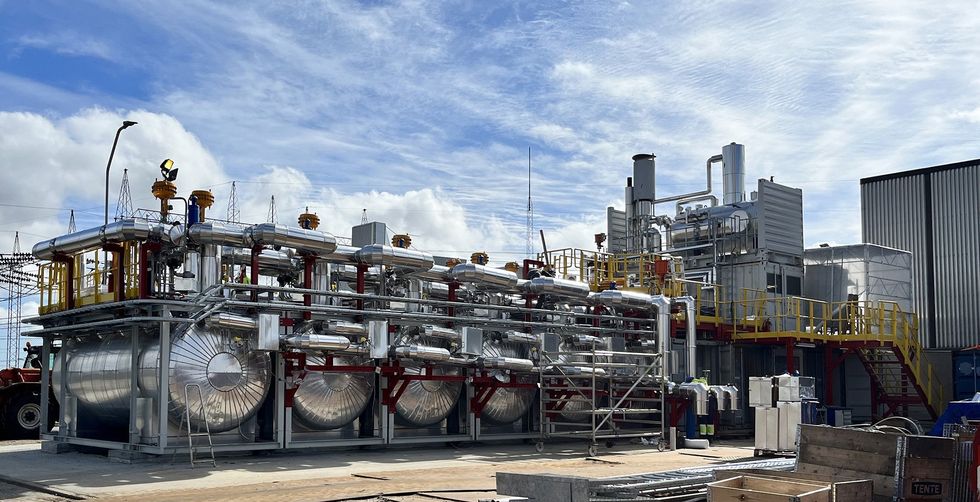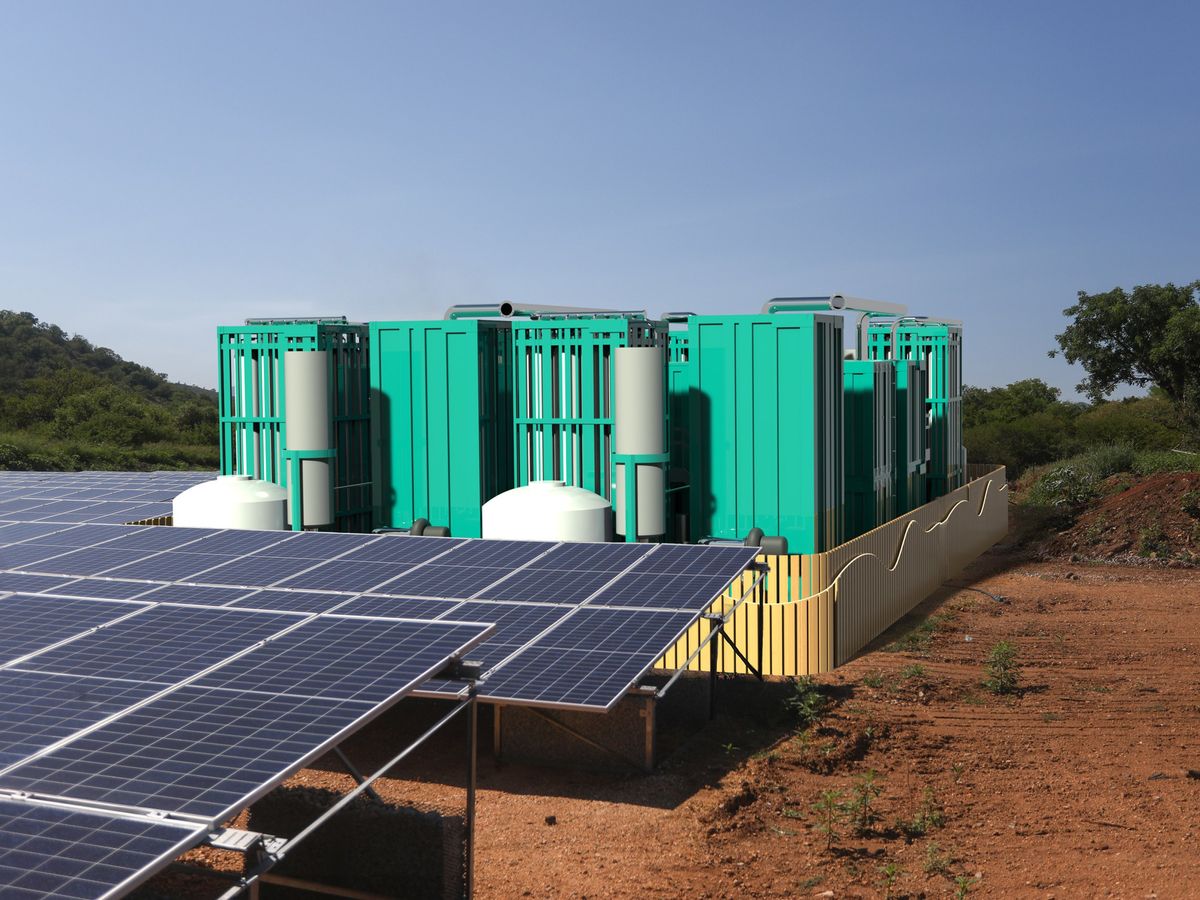Next year, the town of Colchester, England, will transplant four roughly 6-meter shipping containers onto the site of a new mixed-use development. The shipping containers, which house a Frankenstein-like assortment of machine parts—motors repurposed from Volvo truck engines, giant tanks of compressed air, huge silos of piping hot sand—are produced by a company called Cheesecake Energy.
Despite its name, Cheesecake Energy isn’t in the food business. The company is building these shipping-container systems, which work like giant batteries that store energy as heat and pressurized air, rather than a chemical reaction. (Cheesecake’s name is derived from a nerdy acronym for their technology.)
Cheesecake is part of a cohort of companies trying to meet a growing need for alternative forms of energy storage. As countries transition away from fossil fuels to green sources of energy like wind and solar, there will be natural lulls in energy production due to weather conditions. Energy consumption also tends to peak during early evening hours, which is inconveniently right when solar energy output decreases. Energy-storage technology is seen as a way to help even out the imbalance in supply and demand by storing excess energy during periods of high production and using it when needed.
Recent years have seen the construction of large lithium-ion battery farms that do just that. But even energy-dense lithium-ion batteries have limitations, says Xiaobing Liu, who leads the Thermal Energy Storage Group at Oak Ridge National Laboratory (ORNL). Batteries that can hold large amounts of energy are large and expensive, requiring a substantial investment to install. They gradually lose capacity with each discharge-and-recharge cycle, and they can be fire hazards. The raw materials needed to build lithium-ion batteries are also difficult to come by, and mining those minerals raises environmental and human rights issues.
“It’s a rare material, and lots of places need batteries,” Liu said. “Electric cars need lots of batteries, laptops need lots of batteries. So there’s strong competition for the materials, especially if electric cars become more and more popular.”
That’s why interest in unconventional solutions for energy storage has taken off in recent years. Companies have looked into pumped hydroelectric systems that generate electricity from water flowing out of large artificial reservoirs, underground caverns that store hydrogen fuel electrolyzed from water, elevators that lift blocks of concrete and harvest their potential energy as they fall. Some companies have landed on thermal storage.
Storing Energy in Air and Sand
The mixed-use development in Colchester will operate its own microgrid, which gets electricity from an 8-megawatt solar farm on its property. Excess energy generated by the solar farm during the day will be stored in Cheesecake Energy’s thermal energy storage system and accessed during the evening by local businesses and residents.
Here’s how it works: During the day, Cheesecake’s system takes the excess electricity and uses it to turn a motor. The motor drives a piston that compresses air, which gets hot as it’s compressed. The system then wicks off the heat from the compressed air and stores the heat in silos of sand or gravel. The compressed air, now cool and easier to store, is housed in a large air tank.
Cheesecake’s cofounder likes to use a bathtub analogy when comparing the company’s technology to lithium-ion batteries. Energy storage has two main factors—how fast it can be charged and discharged (the spigot) and how much total energy it can hold (the bathtub). Batteries have a powerful spigot, but that comes at the cost of a small tub.
“The bathtub is cheap for us, so when it comes to how much we can store, we can increase that capacity quite cheaply,” says Michael Simpson, the cofounder of Cheesecake Energy. “For batteries, it’s quite expensive to make the bath bigger.”
When it comes time to generate electricity, Cheesecake runs the system in reverse. The compressed air, once heated, drives a piston that runs a generator to produce electricity. The whole system, which can hold five to 12 hours’ worth of electricity discharging at full power, costs a half-million pounds. An additional set of shipping containers will double the storage capacity, and so on.
Don’t Waste Heat Energy
While Cheesecake’s system is primarily an electricity-in, electricity-out storage device, there are other thermal energy storage companies that specialize in releasing stored energy as heat. It’s a somewhat overlooked form of energy, but critically important—energy in the form of heat is how half of the total energy use in the world is consumed, as much as electricity and transportation combined.
A large part of that is due to industrial use by large, energy-hungry industries such as steelmaking, chemical manufacturing, and construction. The startup Kyoto Group, based in Norway, is targeting this industrial use of heat with their thermal storage system, which stores energy in the form of molten salt. Their system can take electricity or heat as input and releases hot air or steam in the range of 170 to 400 degrees Celsius as output. That temperature delivery is well suited for the food industry and paper industry, which have tested pilots of Kyoto’s system. One molten salt thermal-storage device installed at a power station outside Aalborg, Denmark stores electricity from the grid when it’s cheap and releases steam at 180 degrees Celsius to provide heat to the local district heating system.

Buildings are another big consumer of heat, accounting for almost half of total heat consumption, mostly for space and water heating. They also consume 75 percent of all electricity used. That’s why Liu’s Thermal Energy Storage Group at ORNL is focused primarily on buildings. The group’s vision is for more and more buildings to eventually include thermal storage systems. The group is researching ways to integrate thermal storage systems directly into existing building infrastructure like roofs, walls, and floors in ways that don’t take up a lot of space.
Liu hopes thermal energy storage will eventually be as ubiquitous as air conditioners, but he says it will probably take a lot more time because the benefits of the investment are not as obvious. Whereas early adopters of air conditioning could see direct benefits from investing in one (staying cool during hot summer months), home and building owners of thermal storage systems may not.
“Getting a 100 percent decarbonized grid is nothing but an optimization problem.”—Matthew Irvin, Maplewell
Commercial customers may see benefits first—they have to pay a demand charge during times when there’s high overall demand on the grid, so they can save money by pulling energy from thermal storage at those times. But Liu says residential customers don’t see demand charges. Instead, the benefits from thermal energy storage investments go to utility companies by helping take some pressure off the grid.
He says widespread adoption of thermal energy storage may have to be driven by external forces, like the government or utility companies introducing time-of-use rates for residential customers. If a substantial amount of solar or wind energy is on the grid, customers would be able to save money by purchasing and storing electricity during low-rate times.
“California already has this kind of time-of-use rate from electricity generated by solar or wind,” says Liu. “So that may create this need for storage…And then there will be a competition between thermal and electric [storage].”
Heating Up the Grid
On some level, getting value from energy storage systems is an optimization problem. When does it make sense to buy electricity directly from the grid? And when is it best to pull from storage reserves or purchase extra grid electricity to store? Maplewell Energy, a Colorado-based company that makes software that automates these decisions, hopes to make that easy for commercial customers. The software pulls data from different sources—weather reports, utility companies, and records of past energy use—to predict what to do to get the best price for electricity overall.
The company recently piloted its software at an enterprise convenience store, using the convenience store’s own refrigeration system as a type of thermal energy storage. Commercial refrigerators are required to be kept below 40 degrees Fahrenheit, but they have a wiggle room of a few degrees above freezing to play with. Before 4 pm local time, when overall demand from the local grid is highest and most expensive, Maplewell’s software instructs the store’s refrigerators to cool down to the lower end of the threshold so the store can avoid purchasing energy for refrigeration during the peak period.
“For batteries, it’s quite expensive to make the bath bigger.”—Michael Simpson, Cheesecake Energy
Matthew Irvin, the CEO of Maplewell, believes optimization software like this can help with concerns that the grid will run out of capacity trying to support a full transition from fossil fuels to electrification.
“Getting a 100 percent decarbonized grid is nothing but an optimization problem,” says Irvin.
The companies and researchers working on thermal energy storage are optimistic about their technology. If it succeeds, thermal storage devices could help consumers buffer against fluctuations in renewable energy supply and prevent overloading the grid during periods of high demand, all while using materials that are environmentally friendly, simple, and cheap.
But the space is still young. Both Cheesecake Energy and Kyoto Group were founded in 2016, Maplewell Energy in 2019, and even the ORML’s Thermal Energy Storage Group was formed only in December 2022. Companies still struggle with limited public awareness of the technology, and it takes time to scale up from building pilot systems to manufacturing thermal storage products on a large scale. Tim de Haas, the chief commercial officer for Kyoto Group, said the industry also faces regulatory and policy challenges.
But there’s also a growing demand for effective energy storage solutions. Cheesecake’s Simpson said the company’s target customers include those wanting to build new offices or factories but can’t because the local grid is at capacity.
“We’re having real issues in the U.K., where developers want to build housing estates or new commercial developments, and they’re basically told, ‘You can have enough power for that in 2030,’” says Simpson. “The grid isn’t moving fast enough for them.”
Correction 14 June: The story was updated to reflect the Kyoto Group’s location (based in Norway, not the Netherlands as originally reported) and to clarify the role of the power station in Denmark that it’s installed at.



